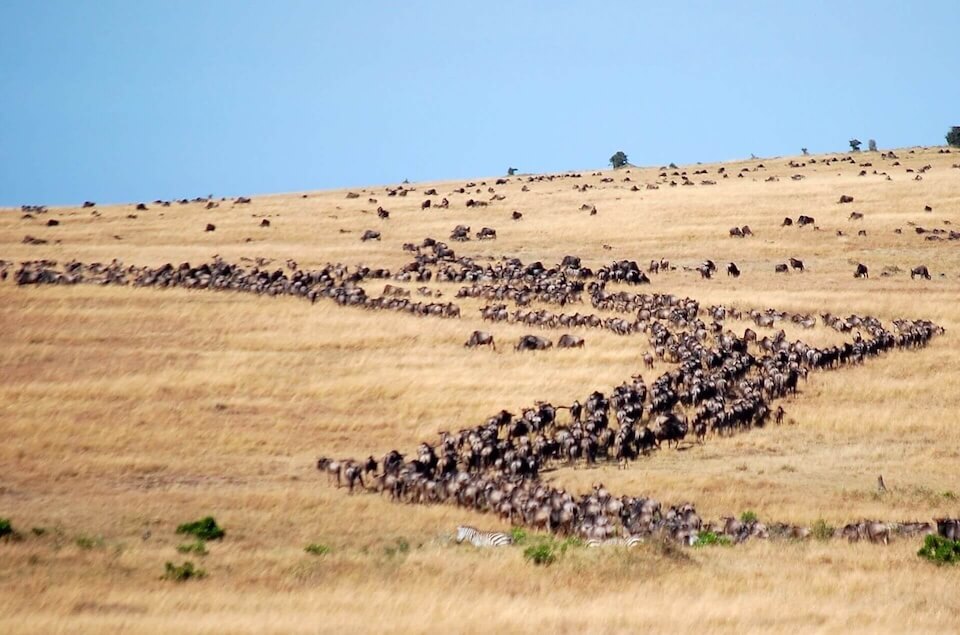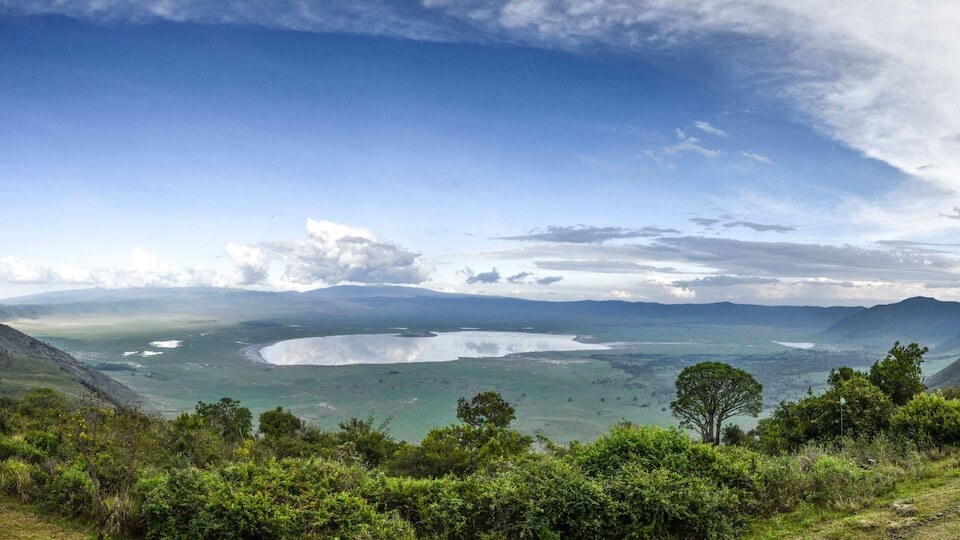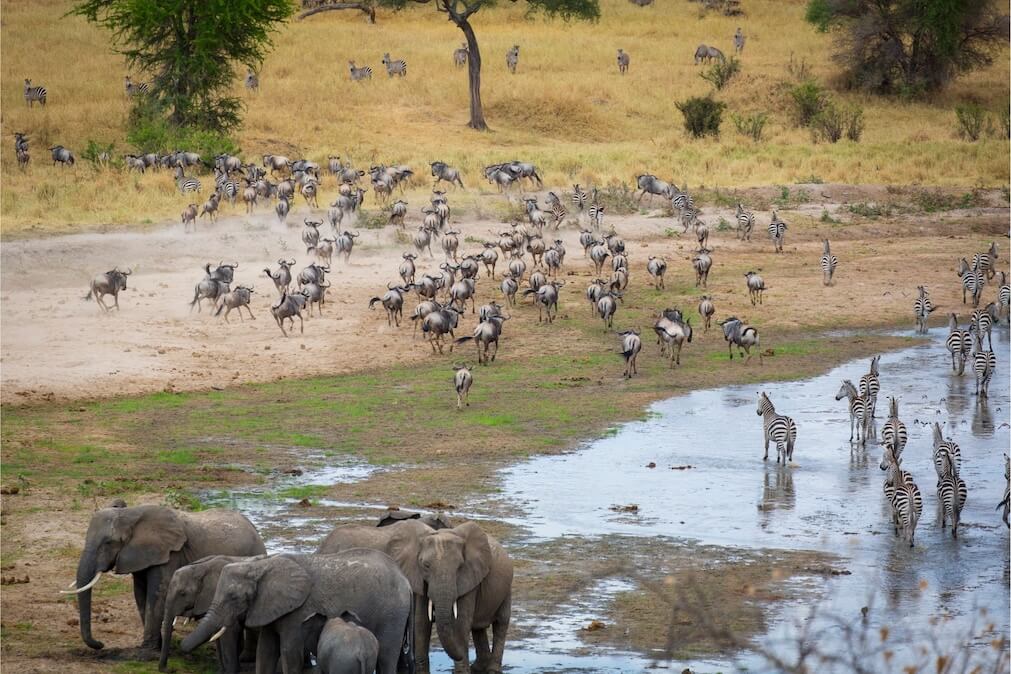When is the best time for a safari in Tanzania?
Tanzania is one of the best safari destinations in the world. However, the best time to travel to Tanzania for a safari depends on what you want to experience. Some months offer impressive animal density in the dry season. In other months, you can observe the spectacular Great Migration in the Serengeti or the quiet weeks of the so-called “green season”. Each season has its own special advantages.
Important: The climate can fluctuate. The information in this article should therefore be seen as a trend and not as a guarantee.
Short answer and overview
The dry season from June to September is considered the most reliable and therefore the most popular time to go on safari in Tanzania. During this period, the days are usually sunny and dry, and with few natural water sources available, rivers and waterholes attract a variety of animals. Elephants, antelopes and predators such as lions and leopards can therefore be observed particularly well. The vegetation is sparser, which also improves visibility.
From December to March, the focus shifts to the south of the Serengeti and the Ndutu region. This is where the wildebeest calving season takes place, with hundreds of thousands of animals giving birth to their offspring at the same time. This event attracts numerous predators and makes the months a highlight for anyone looking for spectacular sightings.
Tanzania shows a completely different side during the rainy season. During the short rainy season, the vuli, in November and December, and during the long rainy season, the masika, from March to May, the landscape turns a lush green. Fewer visitors, lower prices and excellent birdwatching opportunities make this “green season” particularly attractive for many travelers.
Tanzania safari calendar: month by month
The following overview shows you what to expect over the course of the year. It takes into account the weather, animal highlights as well as advantages and disadvantages.
| Monat | Wetter | Highlights | Parks | Vorteile | Nachteile |
|---|---|---|---|---|---|
| Januar | Warm, meist trocken, kurze Regen möglich | Kalbungszeit beginnt in Ndutu, viele Raubtierbeobachtungen | Südliche Serengeti, Ngorongoro | Tierreich, wenige Touristen im Norden | Straßen teils schlammig |
| Februar | Warm, relativ trocken | Höhepunkt der Kalbungszeit (Gnus, Zebras) | Ndutu, Serengeti Süd | Intensives Raubtierverhalten, Fotografenparadies | Lodges stark gefragt |
| März | Beginn der masika (lange Regenzeit) | Tierwanderungen Richtung Westen | Serengeti, Tarangire | Grüne Landschaft, weniger Gäste | Schlammige Straßen, Lodges schließen teils |
| April | Starke Regenfälle (Peak) | Vögel in Brutstimmung | Selous/Nyerere, Ruaha | Günstige Preise, intensiv grün | Kaum Fahrten möglich, eingeschränkte Infrastruktur |
| Mai | Ende der masika | Migration im Westkorridor startet | Serengeti West, Grumeti | Fotogenes Licht, niedrige Preise | Straßenprobleme, Lodges nicht alle offen |
| Juni | Übergang in die Trockenzeit | Beginn Trockenzeit, Tiere an Flüssen | Serengeti West, Tarangire | Sehr gute Sichtungen | Start Hochsaison, Preise steigen |
| Juli | Trocken, kühlere Nächte | Migration zieht nach Norden, Elefanten im Tarangire | Serengeti + Nord, Tarangire | Exzellente Tierkonzentration | Hochsaison, Lodges ausgebucht |
| August | Trocken | Mara-Flussüberquerungen | Serengeti Nord, Mara-Gebiet | Spektakuläre Sichtungen | Sehr voll, früh buchen |
| September | Trocker | Migration noch im Norden, Raubtiere aktiv | Serengeti Nord, Nyerere, Ruaha | Ideale Safari-Monate | Hochsaisonpreise |
| Oktober | Ende der Trockenzeit | Viele Tiere an Wasserstellen | Serengeti, Ruaha, Nyerere | Stabile Safaris, angenehmes Klima | Teilweise Staub, Ende Hochsaison |
| November | vuli (Kurze Regenzeit) | Grüne Landschaft, Zebras und Antilopen aktiv | Serengeti, Tarangire | Weniger Gäste, gute Fotobedingungen | Regenschauer, unberechenbar |
| Dezember | Kurzregen klingt ab | Beginn Kalbungszeit, gute Tierdichte | Ndutu, Serengeti Süd, Ngorongoro | Weihnachtszeit lebendig, viele Tiere | Hochsaisonpreise, Lodges voll |
Where in which month? – Park recommendations
Choosing the right national park depends heavily on the time of year. Each park has its own highlights, which vary throughout the year. If you understand when each region shows its strengths, you can plan your safari optimally.
Best time to visit Serengeti
The Serengeti is famous for the Great Migration and offers spectacular experiences all year round. If you are looking for the best time to visit the Serengeti, you should know that each region of the park has its peak in different months. From December to February, the herds are concentrated in the south, especially around Ndutu. During this time, hundreds of thousands of wildebeest and zebra give birth and predators are at their peak – perfect months for intense game viewing. In May and June, the herds migrate to the Western Corridor, where they cross the Grumeti River with its giant crocodiles. From July to September, the migration reaches the north of the Serengeti. The river crossings on the Mara are among the most dramatic scenes Africa has to offer.
Best time to visit Ngorongoro Crater
The Ngorongoro Crater is a year-round destination. Due to its closed geography and constant water and food supply, the animal density remains stable. Rhinos, lions, elephants, buffaloes and numerous other species can be seen at any time of the year. Even though the crater is popular with tourists, it is one of the absolute highlights of any trip to Tanzania.
Best time to visit Tarangire
From July to November, Tarangire is one of the best parks for elephant watching. Huge herds gather at the Tarangire River, while many other animals are also concentrated here. From March to June, the so-called “small migration” takes place: Many animals leave the park to search for nutrient-rich pastures outside and give birth to their offspring. As there are waterholes everywhere, the animals disperse widely. However, as soon as the dry season begins, these springs dry up and the animals return. The Tarangire River with its permanent water then concentrates an impressive variety of wildlife, which is particularly easy to observe in the dry season. The months from November to May show a completely different side: then the landscape is lush green, less frequented and a paradise for birdwatchers.
Best time to visit Ruaha
Ruaha is a wild and pristine park with fascinating baobab landscapes. The chances of sightings are particularly high from June to October. Prides of lions, large herds of elephants and even wild dogs can be observed during this time. In the rainy season, on the other hand, the vegetation blossoms and the landscape is particularly impressive, but some paths are difficult to drive on.
Best time to visit Nyerere (formerly Selous)
The huge Nyerere National Park is particularly suitable from June to October. In the dry season, the animals gather along the Rufiji River and at numerous lakes. Boat trips are possible here, offering a completely new perspective on elephants, hippos and crocodiles. Outside of these months, the park remains vast and untouched, although it is difficult to access during the long rainy season.
Understanding rainy seasons - vuli and masika
Tanzania has two distinct rainy seasons, each of which characterizes the safari experience in its own way.
The short rainy seasonin Swahili vuli falls in the months of November and December and can sometimes extend into January. During this time, there are usually short, heavy showers that fall in the afternoon or evening. The rain rarely lasts all day. Nature recovers, the plains become lush green and wonderful contrasts are created for photographers. Many lodges and camps remain open during this phase, so safaris are still very much possible. In addition, the national parks are less crowded, which makes for a quieter travel experience.
The long rainy seasonthe masikalasts from March to May. April traditionally sees the most rainfall. Many camps and lodges close during these months as roads and tracks are often difficult to pass. Game viewing can be limited as a result. Nevertheless, this season also has its advantages: Accommodation often offers attractive prices, the vegetation is particularly lush and visitor numbers fall to a minimum. If you are looking for peace and quiet and want to experience nature in all its power, this is the time to gather extraordinary impressions.
Best time to travel by type of trip
Choosing the right national park depends heavily on the time of year. Each park has its own highlights, which vary throughout the year. If you understand when each region shows its strengths, you can plan your safari optimally.
Families, couples and first-time visitors
Those planning their first safari or traveling with the family will find the best conditions in the months of June to September. The weather is stable, the vegetation is thinner and the chances of sightings are very high. Animals are easy to find and the risk of weather-related restrictions is low. The months of January to March are equally interesting in Ndutu, when the calving season makes for particularly exciting sightings. Families with children in particular can experience impressive scenes that will remain in their memories for a long time.
Photographers
The months of June to October are particularly rewarding for photographers. In the dry season, the animals congregate at rivers and waterholes, allowing clear sightings and providing perfect opportunities for impressive shots. Dusty light moods in the evening sun and spectacular landscape backdrops also provide strong contrasts. Another highlight is January and February in the southern Serengeti around Ndutu. During the calving season, hundreds of thousands of young wildebeest and zebra are born and predators are particularly active – ideal conditions for dramatic wildlife photography.
Travelers with a focus on peace and budget
For guests who prefer peace and quiet, a green landscape and attractive prices, the so-called Green Season is ideal. From November to December and from March to May, there are significantly fewer visitors in the parks. Lodges attract guests with cheaper offers, nature is lush and colorful, and birdwatchers find a true paradise. Although occasional rain showers are to be expected, this is often when the most intense light and color moods are created for a special safari experience.
Combine Tanzania safari and Zanzibar
Many travelers combine a Tanzania safari with a Zanzibar beach holiday.
This combination offers the perfect balance of adventure and relaxation: first exciting game drives in the national parks, then relaxation on white sandy beaches with turquoise blue sea.
The months of June to October and December to February are particularly recommended to enjoy both parts of the trip to the full. During this time, safari conditions are ideal with a high density of wild animals that can be easily observed in the dry season. At the same time, Zanzibar offers ideal beach weather during these months with plenty of sunshine and warm water that is perfect for swimming, snorkeling or diving.
Even during the short rainy season in November, the island remains a worthwhile destination. Although short showers can occur, they are usually short-lived and the temperatures remain pleasantly warm.
FAQ
When is the best time for a safari in Tanzania?
From June to October and in January and February. The chances of spotting wildlife are particularly high during these months.
When is calving season in Ndutu?
From the end of December to February, thousands of wildebeest and zebras give birth to their young.
When do the Mara River crossings take place?
Mostly between August and September, when the herds are in the north of the Serengeti.
Is the Green Season worth it?
Yes, for birdwatchers, photographers and price-conscious travelers. The nature is intensely green, there are fewer guests and lower prices.
Conclusion and planning tips
The best time to go on safari in Tanzania depends primarily on your personal interests. If you want to see as many animals as possible, the months from June to October are ideal. During this dry season, the animals gather at rivers and waterholes, making sightings particularly reliable. From December to February, the focus is on the southern Serengeti around Ndutu. During the calving season, hundreds of thousands of wildebeest and zebras give birth to their offspring, accompanied by intense predator activity – a unique spectacle. For those who value peace and quiet, lush green landscapes and lower prices, the so-called Green Season from November to December and March to May is the perfect time. For the high-demand months of July to September and December to February, you should definitely book your accommodation early.
Which park in which month?
| Park | Beste Monate | Besonderheiten |
|---|---|---|
| Serengeti Süd / Ndutu | Dezember bis Februar | Kalbungszeit mit vielen Raubtier-Sichtungen |
| Serengeti West / Grumeti | Mai bis Juni | Flussüberquerungen mit Krokodilen |
| Serengeti Nord / Mara | Juli bis September | Mara-River-Crossings |
| Ngorongoro-Krater | Ganzjährig | Konstante Tierdichte, gute Chancen auf Nashörner |
| Tarangire | Juli bis November | Elefanten am Fluss, große Tierkonzentrationen |
| Ruaha | Juni bis Oktober | Raubtiere, Elefanten, Wildhunde und ikonische Baobabs |
| Nyerere / Selous | Juni bis Oktober | Boots-Safaris, Wasserwild, weite Landschaften |



